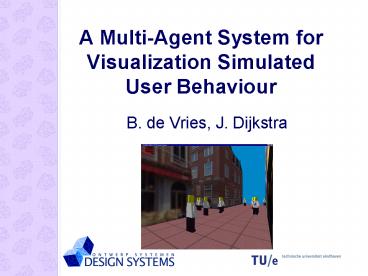A Multi-Agent System for Visualization Simulated User Behaviour - PowerPoint PPT Presentation
1 / 41
Title:
A Multi-Agent System for Visualization Simulated User Behaviour
Description:
T represents the time-budget each user-agent possesses ... A multi-agent model can be used for visualizing simulated user behavior to ... – PowerPoint PPT presentation
Number of Views:81
Avg rating:3.0/5.0
Title: A Multi-Agent System for Visualization Simulated User Behaviour
1
A Multi-Agent System for Visualization Simulated
User Behaviour
- B. de Vries, J. Dijkstra
2
Agenda
- VR-DIS research programme
- B. de Vries
- AI for visualization of human behavior
- J. Dijkstra
3
VR Technology in (Architectural) Design
- Traditional process and use
- Envisioned process and use
4
Traditional process Sketch
- Paper Pencil
- Reflection on Thoughts
- Vague
5
Traditional process Design
- 2D/3D Modeling
- Material use
- Consultancy Installation, Construction, etc.
6
Traditional process Presentation
- Convey design
- Impression of building
7
Envisioned process 3D Modeling
- Direct manipulation
- Implicit relations
- Sculpturing
8
Envisioned process Scene Painting
- Realistic images
- No construction material
9
Envisioned process Evaluation
- Indoor climate
- Lighting
- Structural behavior
- Acoustics
- User behavior
10
Example Urban plan
11
Towards a Multi-Agent System for Visualizing
Simulated User Behavior
12
Introduction of the Model
13
- Architects and urban planners are often faced
with the problem to assess how their design or
planning decisions will affect the behavior of
individuals.
- One way of addressing this problem is the use of
models simulating the navigation of users in
buildings and urban environments.
A Multi-Agent System based on Cellular Automata
14
Essentials of Cellular Automata
15
- Cellular automata are discrete dynamical systems
whose behavior is completely specified in terms
of a local relation
Cellular automata are characterized by the
following features
- Grid
- Time
- Cell
- State
16
Cellular Automata Model of Traffic Flow
17
Agent Characteristics
18
Agent Definitions
Agents are computational systems that inhibit
some complex dynamic environment, sense and act
autonomously in this environment, and by doing so
realize a set of goals or tasks for which they
are designed (Maes).
An autonomous agent is a system situated within
and part of an environment that senses that
environment and acts on it, over time, in pursuit
of its own agenda (Franklin Graesser).
19
Agent Properties
- Autonomy
- - agents have some control over their actions
and internal state - Social ability
- - agents interact with other agents
- Reactivity
- - agents perceive their environment and respond
to changes in it - Pro-activeness
- - agents exhibit goal-directed behavior by
acting on their own initiative - ? Mentalistic capabilities
- - knowledge, belief, intention, emotion
20
Agent Architecture
State
Perception
Action
Sensors
Effectors
Production System
21
Multi Agent Simulation Models
22
Offers the promise of simulating autonomous
agents and the interaction between them.
behaviors evolve dynamically during the simulation
- Evolution capabilities
- evolution of the agents environment
- evolution of the agents behavior during the
simulation - anticipated behavior
- unplanned behavior
23
Towards the Framework
24
Artificial Intelligence
Cellular Automata
Distributed Artificial Intelligence
Multi Agent Simulation Models
25
Motivation
- Develop a system how people move in a particular
environment. - People are represented by agents.
- The cellular automata model is used to simulate
their behavior across the network. - A simulation system would allow the designer to
assess how its design decisions influence user
movement and hence performance indicators.
26
Network Model
The network is the three-dimensional cellular
automata model representation of a state at a
certain time.
27
different neighborhoods
28
transition of a state of a cell
29
Agent Model
30
User Agent
Define an user-agent as U lt R S gt, where
- R is finite set of role identifiers actor,
subject
- S scenario , defined by S ltB, I, A, F, Tgt,
where - B represents the behavior of user-agent i
- I represents the intentions of a user-agent i
- A represents the activity agenda user user-agent
i - F represents the knowledge of information about
the environment, called Facets - T represents the time-budget each user-agent
possesses
31
The Integration of Cellular Automata and Multi
Agent Technology
Initially, we will realize different graphic
representations of our simulation
- a network-based view
- a main node-based view
- an actor-based view
32
network grid and decision points
33
main node-based view
34
actor-based view / network-based view
35
Simulation Experiment
Design of a simulation experiment of pedestrian
movement.
Considering a T-junction walkway where
pedestrians will be randomly created at one of
the entrances.
Some impressions ...
36
(No Transcript)
37
(No Transcript)
38
(No Transcript)
39
Demo
40
Conclusions
41
- Complex behavior can be simulated by using the
concept of cellular automata in the context of
multi-agent technology.
- The development of multi-agent models offers
the promise of simulating autonomous individuals. - A multi-agent model can be used for visualizing
simulated user behavior to support the assignment
of design performance. - The proposed concept potentially has a lot to
offer in architecture and urban planning when
visual and active environments may impact user
behavior and decision-making processes.































